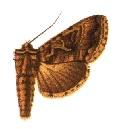
The silver Y is a migratory moth of the family Noctuidae which is named for the silvery Y-shaped mark on each of its forewings.

Plusiinae is a smallish subfamily of the moth family Noctuidae. As the Noctuidae appear to be a paraphyletic assemblage, the Plusiinae may eventually be raised to family status.

Autographa pulchrina is a moth of the family Noctuoidea. It is found in Europe East to the Urals and the Caucasus.Also in the Khentii Mountains (Mongolia) and East Siberia.

Autographa is a genus of moths of the family Noctuidae.
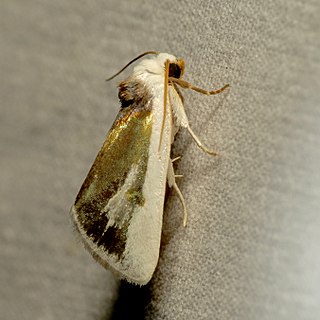
Neumoegenia is a genus of moths of the family Noctuidae. The genus was erected by Augustus Radcliffe Grote in 1882.

Syngrapha is a genus of moths of the family Noctuidae.

The gold spangle is a moth of the family Noctuidae. The species was first described by Michael Denis and Ignaz Schiffermüller in 1775. It is found in Europe, across western Siberia and the Altai Mountains, the northern Caucasus, northern Turkey and northern Iran.

Autographa californica, the alfalfa looper, is a moth of the family Noctuidae. The species was first described by Adolph Speyer in 1875. It is found in western North America from southern British Columbia to Baja California and to Manitoba, South Dakota, Colorado and New Mexico.

Autographa jota, commonly known as plain golden Y, is a moth of the family Noctuidae. The nominate form is found in Europe. while the subspecies Autographa jota anatolica is found in the southern Balkans, south-western Asia, Turkey, the Caucasus, and north-western Iran.
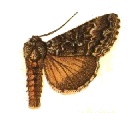
Syngrapha alias, the hooked silver Y, is a moth of the family Noctuidae. The species was first described by Rodrigues Ottolengui in 1902. It is found in North America from Newfoundland to Alaska and Vancouver Island, north to near the treeline and south in the west to coastal north California and Arizona, in the east to North Carolina.
Mychonia is a genus of moths in the family Geometridae. The genus was erected by Gottlieb August Wilhelm Herrich-Schäffer in 1855.

Autographa ampla, the large looper moth, raspberry looper, brown-patched looper or broken-banded Y, is a moth of the family Noctuidae. The species was first described by Francis Walker in 1858. It is found in North America from Newfoundland west to the Alaska panhandle, south to central California, Arizona and New Mexico in the west and North Carolina in the east.
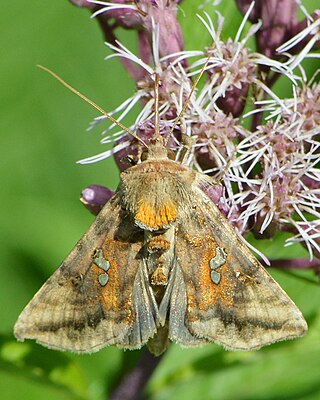
Autographa bimaculata, the two-spotted looper moth, twin gold spot or double-spotted spangle, is a moth of the family Noctuidae. The species was first described by James Francis Stephens in 1830. It is found in North America from Newfoundland west, just short of the coast of British Columbia, north to the Northwest Territories and south to New Mexico in the west and Pennsylvania and Long Island in the east.
Autographa flagellum, the silver whip, is a moth of the family Noctuidae. The species was first described by Francis Walker in 1858. It is found in North America from Newfoundland west across southern Canada to south-eastern British Columbia, south in the east to Maine, Michigan and Wisconsin. There are isolated reports from further south.
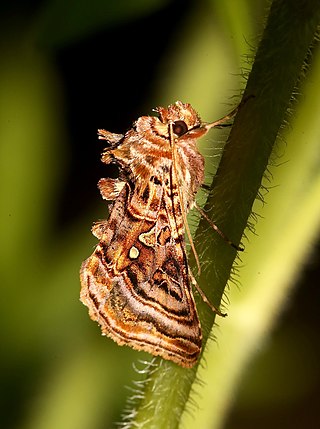
Autographa mappa, the wavy chestnut Y, is a moth of the family Noctuidae. The species was first described by Augustus Radcliffe Grote and Coleman Townsend Robinson in 1868. It is found in North America from Newfoundland west across the wooded portions of Canada to Vancouver Island, south in the east to Maine, New Hampshire and Wisconsin, and in the western mountains south to Colorado and Oregon.
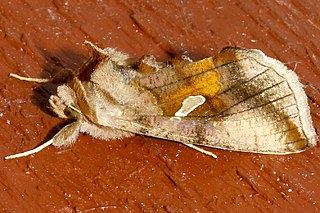
Autographa metallica, the shaded gold spot, is a moth of the family Noctuidae. The species was first described by Augustus Radcliffe Grote in 1875. It is found in western North America from the southern Alaska coast and the Queen Charlotte and Vancouver Islands south to central California, east to the Alberta-British Columbia border and south in the Rocky Mountains to central Colorado.
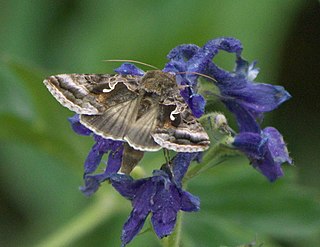
Autographa pseudogamma, the delicate silver Y, is a moth of the family Noctuidae. The species was first described by Augustus Radcliffe Grote in 1875. It is found in North America from Newfoundland to coastal northern Alaska, south in the east to New England and in the western mountains to New Mexico, Arizona and California. It is also found in the Cypress Hills and the Black Hills of South Dakota.

Autographa sansoni, the Alberta beauty, is a moth of the family Noctuidae. The species was first described by F. H. Wolley Dod in 1910. It is found in the western mountains of North America, from Alaska south to Oregon, Idaho and Arizona. Occurring mainly in the Pacific Northwest, it thrives in mid-to-high elevation conifer forest habitat, as well as some areas of coastal rain forest in the Coast range. However, it is also found in a non-contiguous range in sub-alpine forest in the Rocky Mountains, ranging from Alberta in the north, to New Mexico in the south. The wingspan of an adult ranges between 34 and 36 mm. It is widespread, and a relatively common species.
Autographa v-alba, the white Y mark, is a moth of the family Noctuidae. The species was first described by Rodrigues Ottolengui in 1902. It is found in North America from the foothills of Alberta west almost to the coast of British Columbia, south to southern Washington, north-eastern Oregon, central Idaho, northern Wyoming and central Utah.

Archips negundana, the larger boxelder leafroller, is a moth of the family Tortricidae. The species was first described by Harrison Gray Dyar Jr. in 1902. It is found in North America from southern British Columbia to southern Quebec, south to California and Florida.
